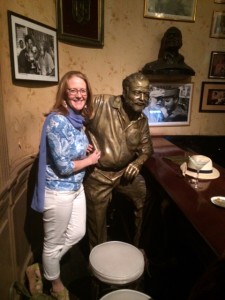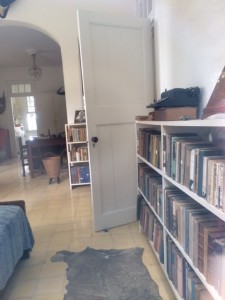 Fifty-three years after the Revolution and with Cubans still suffering from poverty, depravations, and an uncertain future, Havana evokes the imagination with its tangled history and complex aura. I can see why Hemingway loved this place where past and present weave an ongoing story that’s best understood after several strong mojitos.
The country feels fecund to the point of rotting. Old buildings in Havana have been crumbling for decades; elaborate Colonial facades crack and fall daily. Wild vines envelope the shells as sunlight pours in where roofs once shaded. A beleaguered past reveals itself in those deteriorated structures, as well as in the architectural details that have lasted, and in the antique American cars that still function with 300,000 miles on engines built and rebuilt.
Fifty-three years after the Revolution and with Cubans still suffering from poverty, depravations, and an uncertain future, Havana evokes the imagination with its tangled history and complex aura. I can see why Hemingway loved this place where past and present weave an ongoing story that’s best understood after several strong mojitos.
The country feels fecund to the point of rotting. Old buildings in Havana have been crumbling for decades; elaborate Colonial facades crack and fall daily. Wild vines envelope the shells as sunlight pours in where roofs once shaded. A beleaguered past reveals itself in those deteriorated structures, as well as in the architectural details that have lasted, and in the antique American cars that still function with 300,000 miles on engines built and rebuilt.
Those cars, which we've all seen in photos, aren't just a tourist attraction, but a way for their owners to make a better living than the twenty-dollar-a-month salaries paid by the government to three quarters of the population. Tips from tourism, the black market, and money sent from relatives overseas are among the only ways to get by.
Artists and writers who sell their work outside the country are better off than most—outranking doctors and lawyers and what’s left of a professional class. But, I'm not a political scientist or an historian, so I'll leave it to others to describe the economics of this tiny county which has three currencies.
Instead, I was struck by how Cuba beckons the imagination and invites creativity. Hemingway knew it. He lived on the island for close to thirty years, drank in the Havana bars and then, at the insistence of his new wife, moved out from the center of town to what is now part of the dilapidated sprawl. (More about Finca Vigia and the Hemingway Collection is pictured here: The Ernest Hemingway Collection)
His house sits on a shaded hill and from his turret writing room with windows on all sides, he would have watched over the city he loved and the sea beyond. Now, tourists line up at the threshold of the main house and lean in the open windows that line the porch.
We're no longer allowed inside and while I thought that would bother me, it didn't. In a way, it just added to the feeling that this was a pilgrimage culminating with the supplicants gazing in at the ghost of our deity, as embodied by the Big Man's floral reading chair, his many crowded bookshelves, and all those African big game heads peering back.
I was left more than a little speechless by the sight of his two typewriters. Up in the many-windowed turret sat a simple desk and on it, his tiny war correspondent's typewriter. I could imagine his large fingers pecking out For Whom the Bell Tolls on those stiff black keys.
And then, even more moving, was his second Remington—none too large, either—sitting atop one of his bookshelves, so that when he stood at it, he faced a white, imperfect plaster wall. No view of the sea. No view of the garden. Just that wall before him.
As he wrote, he planted his bare feet on an African animal skin. Its brown fur is matted and threadbare now, and it isn’t very large. If he happened to lose his balance—which, hung over as he often was, he very well might have—he would have stepped off and onto the cool tile floor. He believed the animal skin brought him strength, clarity, and the mojo to write. Clearly, it did.
He had escaped the noise and bustle of Havana, not to mention the lure of the bars, to find something like peace in that cool, quiet house. Biographers can describe how his marriage was going to hell, or how his liver was being pickled, or he was entangled with Castro, or the FBI, or both.
But, his place and the whole island, feels to this day like a paradise for the mind—haunted and inviting and rich with stories not yet told. Fellow writers, book your trip.
